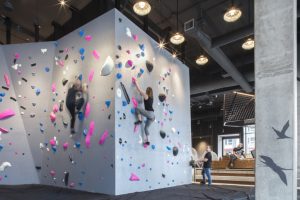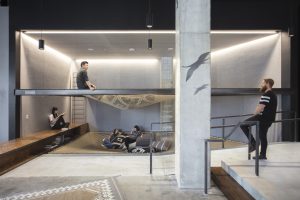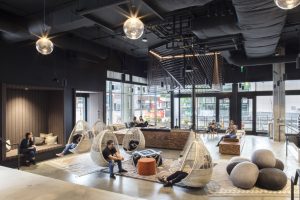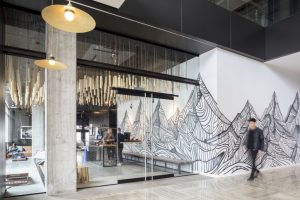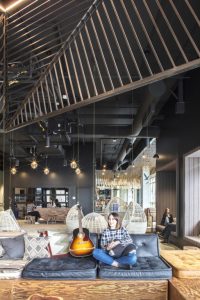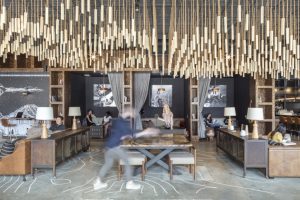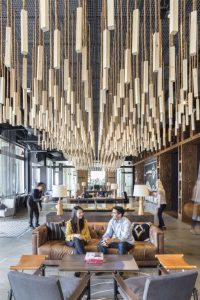Authentic, local and adaptable: These are the qualities of our current and evolving global retail platform. As static, one-stop shops become a thing of the past, customers are crafting a new retail environment in “third places” – spaces that begin to blur the lines between living, working and playing. Utilizing an authentic and local approach to community and sourcing, these spaces are creating a collaborative spirit in our cities.
One such project is The Collective, located in Seattle. Featuring a boutique bouldering gym, day-and-night bar, sunken fire pit, a two-story hammock garden and collaborative workspaces, this 15,000-square-foot space reimagines traditional private club elements and pairs them with activities that instill a sense of community and enhance experience.
Authenticity is the core driver of these spaces. From programming to services, all the way to the most minor construction detail, the story of any retail space should be consistent and have a layer of care that customers feel in their bones. In The Collective, for example, local materials and finishes such as plywood, antique padlocks, timeworn surfaces and pure wool Pendleton rugs, create a woodsy, rustic atmosphere, paying ode to Seattle’s rugged landscape. The entire space is based on the concept “where the land meets the sea,” from the large-scale wood dowel installation – a depth perception map of Puget Sound – to the boat cleats on the bar that serve as purse hooks, the details are tied together both in concept and authenticity.
Designers and owners should be asking themselves how every touchpoint ties back to their core mission and purpose for the space. What are you trying to say with the napkin people place carefully in their lap? How are customers greeted? Are they greeted at all? What’s the smell? Is there music playing? Authenticity is not simply achieved on the physical, tactile level, it’s a full sensory experience.
Your space should have a sense of expression and individuality – where people feel connected to their city and local craftsmen. There is a way of accepting the way things are instead of trying to force them to be something they’re not. When you start to speak a language in materiality, in music and in food, it gives permission for the community you are crafting to act the same – no fuss. When you design from a level of care and purity, the program and that community will be generated in the same way. In The Collective, there are fewer places for people to sit alone, creating settings where people can meet, network and date, to name a few. This generates a concept of connection and communal living. The space is raw, and in the same way, the interaction is real.
Local is the new black. My grandfather used to say, “Once in your life, you may need a doctor, a lawyer, a policeman and a preacher, but every day, three times a day, you need a farmer.” Food matters because it’s one of the things that allows us to live in this world. Food is a reminder of our humanity and our fragility. I’m talking about feeding someone with honesty and intimacy, about creating a place where people feel connected over food. By utilizing local crops and farmers, local labor, local materials and local artists, your space starts to tell the real story of a city and location, while forming connections across clientele and industries. The best way I have found to harness this through design, aside from local food, is to engage local artists. Artists have a sense within them and their creative process is to connect to what you, the designer, are trying to craft holistically. From there, they can deliver a product that not only fits in aesthetically but carries the emotive quality as well. Because of this, your space begins to acquire a new level of customization.
Advertisement
When crafting a boutique, Adaptable programming gives operators the ability to adjust to clients’ daily needs and wants. The reality is that retail is a service-based industry, an evolving organism with the goal of creating social community. Though the quality of product is indeed necessary and vital to brand success, millennials are now spending their money on experiences. The question then becomes, “How do you design an experience that’s worthwhile?” Answer: It must tug a bit at the heart strings. Your space cannot simply speak design, it must speak connection.
These items lend themselves to a new era of projects and clients; various types of evolving, inclusive brand platforms are going to continue to horizon. When you craft a space where people feel welcome and seen, they will not want to leave. Your authentic, local, and adaptable business will turn a profit simply by connecting with each customer. People will engage with your business as their community – a place where they feel known and remembered.
 |
Don't miss Tommy Trause and Adriana Oxford’s session at VMSD's International Retail Design Conference (IRDC), Oct. 2-4 in Seattle. Their breakout session entitled “The Collective Spirit” will focus on experiential concepts at retail through the lens of The Collective, a new urban social club in Seattle. For more information about their session and others, visit irdconline.com.
|
Adriana Oxford has called many places her home and brings her expansive world view from more than 30 countries to her design process. As a passionate hospitality designer in Gensler’s Houston office, Adriana brings a fresh perspective to the latest trends impacting retail, restaurant, workplace and private club amenities. She enjoys the world of opposites – large scale spatial intervention combined with the comfort of small, tactile moments that set a scene for people to connect. Upon graduating from the University of Texas where she earned concurrent degrees in Fine Arts and Business, she moved to Los Angeles where she worked under global designer, Kelly Wearstler. She later received her MFA in Interior Design from the Savannah College of Art and Design. Adriana delights in travelling, running, painting, and yoga and is driven by her optimistic and confident approach to life.


 Photo Gallery6 days ago
Photo Gallery6 days ago
 Headlines2 weeks ago
Headlines2 weeks ago
 Headlines6 days ago
Headlines6 days ago
 Headlines1 week ago
Headlines1 week ago
 Headlines2 weeks ago
Headlines2 weeks ago
 Headlines7 days ago
Headlines7 days ago
 Designer Dozen2 weeks ago
Designer Dozen2 weeks ago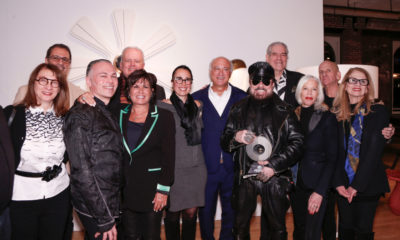
 Special Reports2 weeks ago
Special Reports2 weeks ago



